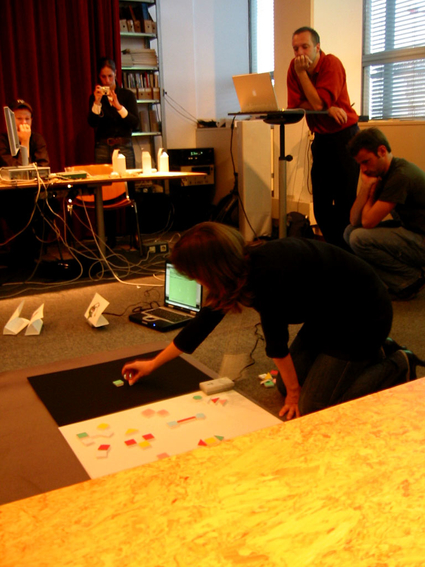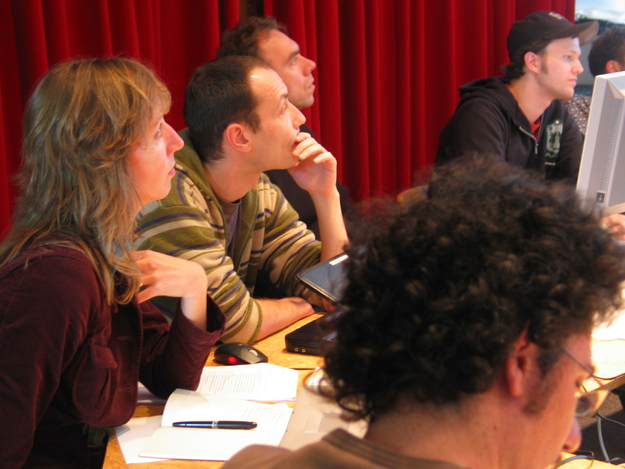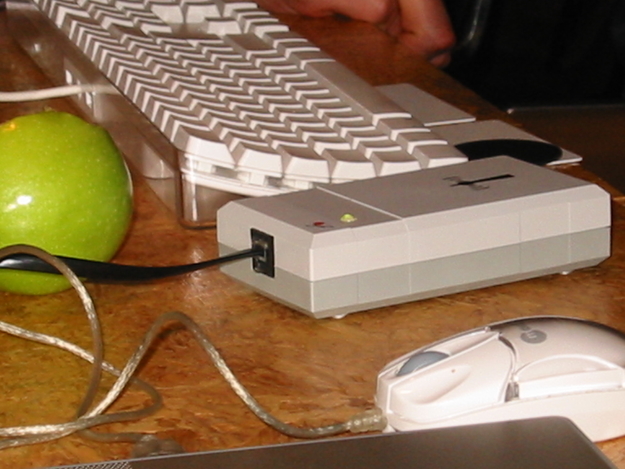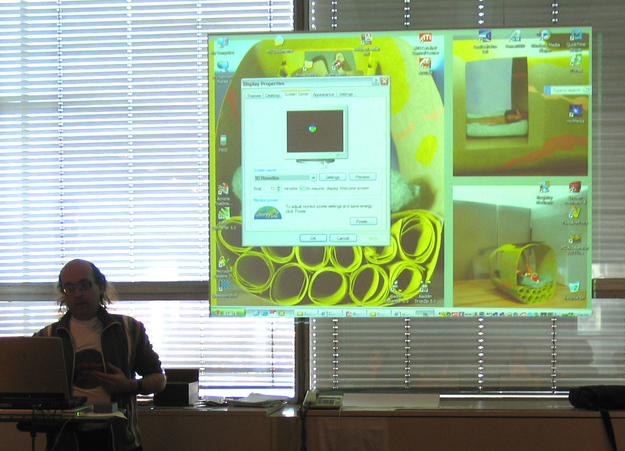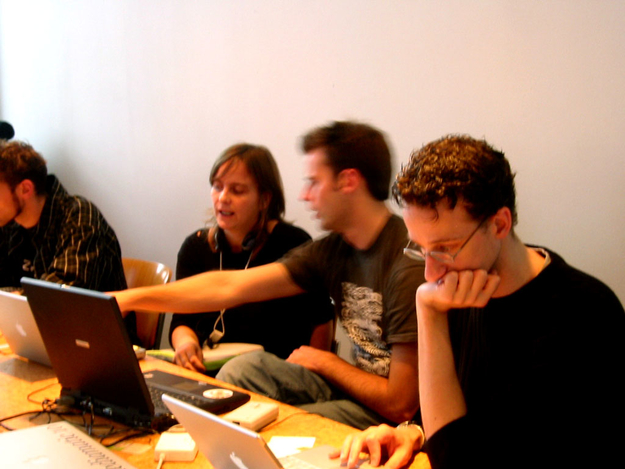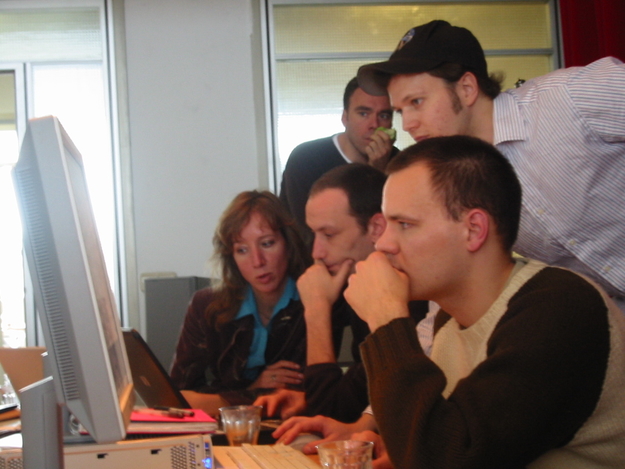Radio Frequency Identification (RFID) is the barcode of the future. With RFID individual objects are equipped with a chip (an RFID tag), which can be read with an RFID reader from a range of up to several meters. To these tags a lot of desired (or undesired) data can be attached for a longer or shorter period of time.
Instead of waiting for and commenting on a next hype of services that allow us to do old things in new ways, this workshop aims to seize some initiative.
How can we make use of RFID in meaningful ways? What sensible or beautiful things can be done with RFID that couldn't be done before? How can RFID be applied in a social context, in urban projects, in interaction and experience design? How can we appropriate this technology for our own purposes?
In this workshop the participants design (creative) streetlevel uses of RFID.
Trajectory
The workshop will take 3 days. The morning sessions of the first and second day are dedicated to presenting interesting cases of RFID, delineating the range of possibilities as well as constraints of this technology. Subsequent lectures and discussions will frame social and philosophical dimensions of a changed communication environment.
On the first day, participants will get acquainted with the practical layout of an RFID environment. For this purpose an RFID set, consisting of tags, readers and a database, will be available. Participants can use this setup to test their own ideas and concepts. Experienced staff will be present for technical assistence. The workshop will be concluded with a presentation of all concepts developed during the workshop.
Target Group
Triggered by RFID is made for a maximum of 16 designers, artists, thinkers and makers who are interested in this technology as a communicative tool. In this workshop you can try out the technology and develop first layouts of possible applications, alternative uses and hacks.
Where?
The workshop will take place in the seminar room of Mediamatic.
The reader for this workshop is online. Come back for frequent updates.
Workshop Report
The second Triggered by RFID workshop hosted by Mediamatic continued to be the fruitful mixture of lectures about both technology and application as well as working on project proposals to understand the social and artistic implications of the upcoming widespread use of RFID technology.
Day 1
After being welcomed by Mediamatic’s Klaas Kuitenbrouwer and having had a small round of self-introduction of the very diverse group of participants, the three-day workshop started off with a lecture by Matthew Karau. Since he has been working as a researcher for the MIT Media Lab as well as for the Media Lab Europe, he has great expertise in working with and prototyping RFID-technology applications. Matthew gave an overview of the current state of the art in tags and readers, how the technology works, how artists can put it to use for their projects, were the limits of the technology currently are and, of course, how to overcome them. Different scenarios were laid out, including the industry’s motivation to use RFID as a replacement for conventional barcodes and the privacy-rights community’s concerns on that.
Later that day, the Dutch artist Han Halewijn presented his project Tagged Space which was exhibited earlier this year in Apeldoorn. The installation was set up in conjunction with a sculpture exhibition in public space and its visitors were carrying tags which enabled them, just by walking around the area, to collaboratively write texts. The movement and “grounding??? of any individual person would generate color-coded words within a story which then later could be accessed online. RFID tags were handed out to the visitors, while RFID readers hidden in birdhouses were waiting to scan them. After the discussion about Tagged Space, Klaas Kuitenbrouwer moderated a roundup in which the participants had the chance to talk about RFID-related projects they might already have in mind, collecting thoughts and initial ideas, and also proposing the participants to form small groups in which they would continue to work on their ideas.
Day 2
Day two started with a lecture by the notorious blogger Régine Debatty, whose we-make-money-not-art had swiftly become one of the main hubs for everyone who is interested about art and technology. Régine gave an overview of her own work as well as of the many RFID-related projects she had blogged about earlier, covering a wide range of different approaches and interests in the subject. This greatly helped the participants in getting an overview in what’s already been done and contextualizing their own work. After Régine, there was another presentation by Joost Broersen who had already been a participant in the first Triggered by RFID workshop and now re-turned to talk about the work that he had accomplished since. His main field of research is the subject of smart objects and spaces that are aware of what they are containing. He talked about the practical aspects of everyday usage of RFID technology, like the importance of being able to shut tags off and having a generally people-centered approach. Finally, Joost presented several designs for forms of interaction with and through common objects which would have great implications on everyday life and the organization of housing environments if realized. Matthew Karau continued with presenting a brief sketch of how to access an RFID-setup from the programming environment Processing, comprehensably explaining the example code he had prepared for the workshop and connecting some tags to read out their stored information.
Having worked on projects in groups after lunchbreak, also the second day was finished by a roundup of the current state of the individual participant’s or group projects. Despite everyone having listened to projects all day long, there was a lively discussion and lots of peer-critiques for almost every project.
Day 3
The third and final workshop day was kicked off by Oslo-based designer and teacher Timo Arnall who is currently researching the graphic language of electromagnetic communication. He gave a very deliberate overview about what he sees as the most interesting aspects of visually tagging the city through all kinds of bottom-up forms of communication and wrapped up the subject by presenting his own designs for areas that are meant to be RFID-enabled. After Timo there was another slot for working on the projects. The last presentation was held by Daniel Van Gils who was, as the final presentation was scheduled later that day, talking more in-depth about prototyping projects, both conceptually and practically, when working with RFID technology. Daniel then stayed the rest of the day and was just like Mattew Karau available for hands-on help with the participants’ projects.
The workshop was closed by a presentation of all projects that have been conveyed by the different groups of participants over the three days. While some had pretty deliberate concepts worked out and were making plans for putting them into practice, three projects were actually already working as very simple prototypes.
